|
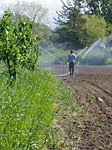 The Sequim Valley receives about 17 inches of average annual rainfall, due to the rain shadow effect of the Olympic Mountains. Work on irrigation starts in late March as we begin prepping infrastructure in anticipation of the water being turned on and flowing through the ditches on April 15. The season wraps up on September 15, when the ditches are turned off until the following spring. A heavy snowpack in the mountains ensures that we will not have to worry about the possibility of a drought, but in low-snow years, water easily becomes the focus of the entire season. We would have to drastically change our cropping patterns without irrigation water from the snowpack-fed Dungeness River. The Sequim Valley receives about 17 inches of average annual rainfall, due to the rain shadow effect of the Olympic Mountains. Work on irrigation starts in late March as we begin prepping infrastructure in anticipation of the water being turned on and flowing through the ditches on April 15. The season wraps up on September 15, when the ditches are turned off until the following spring. A heavy snowpack in the mountains ensures that we will not have to worry about the possibility of a drought, but in low-snow years, water easily becomes the focus of the entire season. We would have to drastically change our cropping patterns without irrigation water from the snowpack-fed Dungeness River.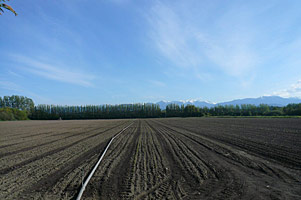
Because Nash's fields are at the end of the Cline and Dungeness Irrigation Ditches, several other farms have access to the water before we do. Making sure the water is distributed evenly takes patience and a lot of relationship-building. Irrigation equipment such as pumps, main lines, lateral lines, sprinkler heads, seals, gaskets and pipe trailers also have to be kept in working order for everything to run smoothly.
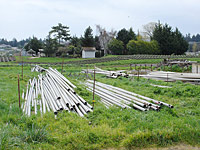 The farm has traditionally used aluminum pipe lines, 20 or 40' long, moved by hand every eight or so hours along a field. In 2005, the farm purchased the first of three irrigation cannons with retractable hoses for the grain. A serious drawback with both these systems is the force that expels the water from the nozzles, called psi (pounds per square inch). The hand lines have a psi of 50 to 60, and the jet can push water out at 100 psi. The farm has traditionally used aluminum pipe lines, 20 or 40' long, moved by hand every eight or so hours along a field. In 2005, the farm purchased the first of three irrigation cannons with retractable hoses for the grain. A serious drawback with both these systems is the force that expels the water from the nozzles, called psi (pounds per square inch). The hand lines have a psi of 50 to 60, and the jet can push water out at 100 psi. 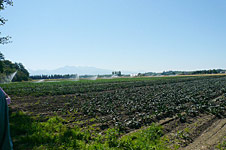 On a sunny day, as much as 50% of the water is lost to evaporation as the droplets shoot upwards and outwards. What remains in the stream pummels the plants and soil as it falls. On a sunny day, as much as 50% of the water is lost to evaporation as the droplets shoot upwards and outwards. What remains in the stream pummels the plants and soil as it falls.
If all goes according to plan, the three-person irrigation crew spends their days moving aluminum pipes around fields and laying them in rows several hundred feet long. After soaking an area about 40 feet on either side of the pipe, the crew moves the line piece by piece 60 feet over to the next section of field. There are six pumps throughout the farm, and one pressurized gravity system.
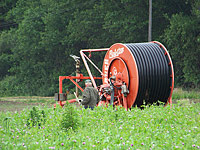 The irrigation cannon shoots water about 300 feet and broadcasts it in the shape of a fan. Its mechanism slowly pulls it backwards over several hours, inching it across the field. The irrigation cannon shoots water about 300 feet and broadcasts it in the shape of a fan. Its mechanism slowly pulls it backwards over several hours, inching it across the field. 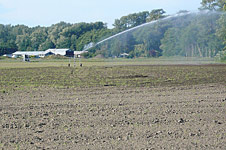 This works well with grains and some vegetables, but the force of the water limits its use. We also lay black drip tape and utilize drip irrigation for some crops, including cucumbers, basil and summer squashes. However, the lion's share of irrigation at Nash' is the familiar pump and pipe system. This works well with grains and some vegetables, but the force of the water limits its use. We also lay black drip tape and utilize drip irrigation for some crops, including cucumbers, basil and summer squashes. However, the lion's share of irrigation at Nash' is the familiar pump and pipe system.
Nash Huber served on the Clallam County Soil Conservation District from 2003 to 2007. One of the District's most important efforts has been the piping and covering of the old irrigation ditches, preventing water loss from 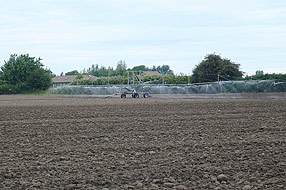 evaporation and ground absorption, protecting the quality of the water and leaving more of it in the river for salmon. evaporation and ground absorption, protecting the quality of the water and leaving more of it in the river for salmon.
In 2011, with help from the Clallam Soil Conservation District, the farm got a grant from the USDA Environmental Quality Incentive Program (EQIP) to help pay the cost of a low-pressure spray boom that irrigates a swath up to 236-feet wide with a gentle mist from a few feet off the ground. This distributes the water accurately and evenly, and does not damage the plants or compact the soil. It also saves about 50% of the water and energy normally expended with the other systems.
The boom system produces a spray at 35 to 45 psi, simulating a gentle rain. Its nozzles are pointed downwards from 50 to 90 inches, depending on the crop. The boom is collapsible, making it easy to transport from field to field. This new piece of equipment is a tremendous savings in labor, water, and energy.
|





